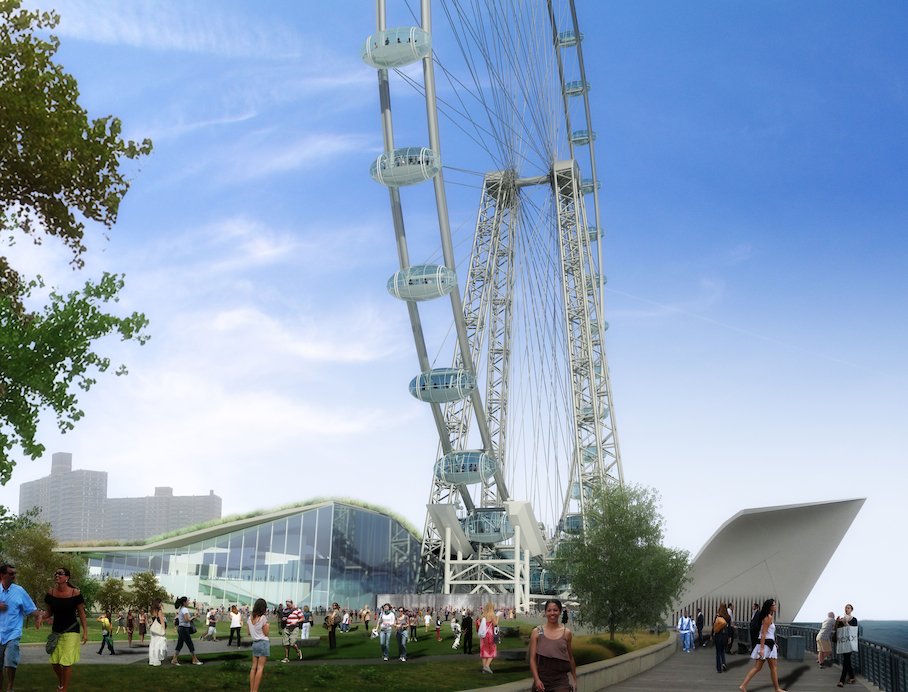Observation Wheel Technology
State-of-the-art engineering has made larger and more sophisticated observation wheels possible. Here’s a look at some of the latest observation wheel technology and a peek at what’s to come in the future.
Propulsion Systems
How do observation wheels rotate? Observation and Ferris wheels use hydraulic motors driven by electric pumps to provide energy to rotate the giant wheels. The hydraulic motors power standard truck tires placed along the rim of the wheel that act as friction rollers. The rotating tires rub against the rim of the wheel structure forcing it to rotate on its axis. A computer controls the hydraulic motor speed for every tire. In the event of a power loss during operation, the wheel has an emergency generator. There’s also a battery back-up braking system for an extra layer of redundancy.
Cables and Dampers
Some observation wheels, such as the London Eye, are held in place by large cables. Attached to each cable is a “stockbridge damper.” These tuned mass dampers are used to suppress wind induced vibration on the taut cables by dissipating the energy of any oscillations. You can often see the dampers attached to the outer rim to prevent the wheel from vibrating at its natural frequency.
Capsules
Observation wheel capsules are typically secured to the outer rim of the wheel and are aerodynamically shaped for the least amount of wind resistance. There is a built-in stability system, meaning the capsule will remain upright and parallel to the ground even if all the passengers were to suddenly move to one side of the cabin. The large glass windows that surround passengers ensure that the views are magnificent and unobstructed and protect against ultraviolet rays. Many use heating and air conditioning along with sophisticated condition monitoring systems to keep guests comfortable all year round.
Transportable Wheels
Thanks to the popularity of the original Chicago Wheel, carnivals and other traveling shows were quick to take advantage of smaller wheels that could be quickly disassembled and transported on trailers. These have been a staple of local fairs and carnivals around the world for over a century and will likely continue to hold a place for many years to come. However, they are no longer the mini versions of observation wheels they used to be. The current record for a transportable Ferris Wheel is the R80 XL by Ronald Bussink.
Transportable wheels are often easier to get permission from a city to build because they can easily be disassembled and moved if they fall out of favor with the local residents.
Some transportable observation wheels, such as the Ronald Bussink 60 meter tall models, need no permanent foundations to remain safely standing upright. Instead 11,000 US gallons of water ballast provide a stable base. These transportable wheels are designed to be erected in seventy-two hours and dismantled in even less time by a properly trained team. Transport requires eighteen 20-foot long trailer trucks.
Lighting Packages
Many large observation wheels feature elaborate lighting packages and look visually stunning at night. The latest illumination technologies include special LED RGB multicolor lights that provide a spectacular display. Wheels sometimes employ clusters of LED lights each with a microprocessor allowing networked control of lighting color, intensity, or effects. Wheels can be coated in every color imaginable at the click of a button and can even create choreographed light shows.
The SkyVue observation wheel in Las Vegas is planning to kick it up a notch by installing the largest LED screen in the world to the side of the observation wheel. The screen is said to be so massive you’ll be able to see it from every airplane flying into and out of Las Vegas. With over 100,000 square feet of high definition LED screen, SkyVue integrates the bright lights of Times Square with the eye popping views of the London Eye. SkyVue will forever transform the Vegas skyline.
The Future
Technology and social media will play an even larger role in the design of new observation wheels. In the future, some wheels may employ augmented reality on the glass windows of the passenger capsules. The transparent touchscreens could contain information on the structure, facts on the city it resides in, and corporate brand marketing.
Read about Ferris wheel physics.
